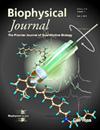tRNA kinetics on the ribosome depends non-monotonically on intersubunit rotation.
IF 3.2
3区 生物学
Q2 BIOPHYSICS
引用次数: 0
Abstract
In order to translate messenger RNA into proteins, the ribosome must coordinate a wide range of conformational rearrangements. Some steps involve individual molecules, whereas others require synchronization of multiple collective motions. For example, the ribosomal "small" subunit (∼1 MDa) is known to undergo rotational motion (∼10°) that is correlated with large-scale displacements of tRNA molecules (∼50Å). While decades of biochemical, single-molecule and structural analysis have provided many insights into the timing of these motions, little is known about how these dynamical processes influence each other. To address this, we use molecular simulations to isolate specific interactions that allow tRNA kinetics to be controlled by subunit rotation. Specifically, we applied an all-atom structure-based model to simulate movement of tRNA between ribosomal binding sites (P/E hybrid formation). These calculations reveal a pronounced non-monotonic dependence of tRNA kinetics on subunit rotation, where the rate of P/E formation initially increases and then decreases as the subunit rotates. In addition, there a sharp increase in rate for low degrees of rotation, suggesting that adoption of P/E tRNA conformations may occur early in the rotation process. Together, these calculations demonstrate how molecular structure gives rise to an intricate relationship between these complex rearrangements.核糖体上 tRNA 的动力学非单调地取决于亚基间的旋转。
为了将信使 RNA 翻译成蛋白质,核糖体必须协调各种构象重排。一些步骤涉及单个分子,而另一些步骤则需要多个集体运动的同步。例如,已知核糖体 "小 "亚基(∼1 MDa)会发生旋转运动(∼10°),这种运动与 tRNA 分子的大规模位移(∼50 Å)相关。几十年来的生化、单分子和结构分析为这些运动的时间安排提供了许多见解,但对这些动态过程如何相互影响却知之甚少。为了解决这个问题,我们利用分子模拟分离出特定的相互作用,使 tRNA 动力学受亚单位旋转的控制。具体来说,我们采用基于全原子结构的模型模拟核糖体结合位点之间 tRNA 的运动(P/E 杂交形成)。这些计算揭示了 tRNA 动力学与亚基旋转之间明显的非单调依赖关系,即随着亚基的旋转,P/E 的形成速率先是增加,然后减少。此外,低旋转度的速率急剧增加,这表明 P/E tRNA 构象的采用可能发生在旋转过程的早期。这些计算结果共同证明了分子结构如何在这些复杂的重排之间产生错综复杂的关系。
本文章由计算机程序翻译,如有差异,请以英文原文为准。
求助全文
约1分钟内获得全文
求助全文
来源期刊

Biophysical journal
生物-生物物理
CiteScore
6.10
自引率
5.90%
发文量
3090
审稿时长
2 months
期刊介绍:
BJ publishes original articles, letters, and perspectives on important problems in modern biophysics. The papers should be written so as to be of interest to a broad community of biophysicists. BJ welcomes experimental studies that employ quantitative physical approaches for the study of biological systems, including or spanning scales from molecule to whole organism. Experimental studies of a purely descriptive or phenomenological nature, with no theoretical or mechanistic underpinning, are not appropriate for publication in BJ. Theoretical studies should offer new insights into the understanding ofexperimental results or suggest new experimentally testable hypotheses. Articles reporting significant methodological or technological advances, which have potential to open new areas of biophysical investigation, are also suitable for publication in BJ. Papers describing improvements in accuracy or speed of existing methods or extra detail within methods described previously are not suitable for BJ.
 求助内容:
求助内容: 应助结果提醒方式:
应助结果提醒方式:


